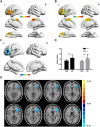Functional insights into aberrant brain responses and integration in patients with lifelong premature ejaculation
- PMID: 28352072
- PMCID: PMC5428429
- DOI: 10.1038/s41598-017-00421-3
Functional insights into aberrant brain responses and integration in patients with lifelong premature ejaculation
Abstract
Even though lifelong premature ejaculation (PE) is highly prevalent, few studies have investigated the neural mechanisms underlying PE. The extent and pattern of brain activation can be determined through a version of functional magnetic resonance imaging (fMRI) with erotic picture stimuli (task fMRI) and a resting-state fMRI (rs fMRI). We showed that the brain activity in the left inferior frontal gyrus and left insula was decreased both during the task and in the resting state, while there was higher activation in the right middle temporal gyrus during the task. Higher functional connectivity was found in PE between those three brain areas and the bilateral middle cingulate cortex, right middle frontal gyrus and supplementary motor area. Moreover, the brain activity had positive correlation with clinical rating scales, such as intravaginal ejaculatory latency time (IELT) and the Chinese Index of Premature Ejaculation (CIPE). These findings revealed that brain responses and functional integration in certain brain areas are impaired in cases of PE, which was consistently supported by multiple measurements obtained using a task and rs fMRI approach.
Conflict of interest statement
The authors declare that they have no competing interests.
Figures





References
-
- Serefoglu EC, et al. An evidence-based unified definition of lifelong and acquired premature ejaculation: report of the second international society for sexual medicine ad hoc committee for the definition of premature ejaculation. Sexual medicine. 2014;2:41–59. doi: 10.1002/sm2.27. - DOI - PMC - PubMed
-
- Malavige L, Jayawickrema S. Premature ejaculation and its management. Sri Lanka Journal of Diabetes Endocrinology and Metabolism. 2015;5:13–19. doi: 10.4038/sjdem.v5i1.7267. - DOI
Publication types
MeSH terms
LinkOut - more resources
Full Text Sources
Other Literature Sources
Medical

